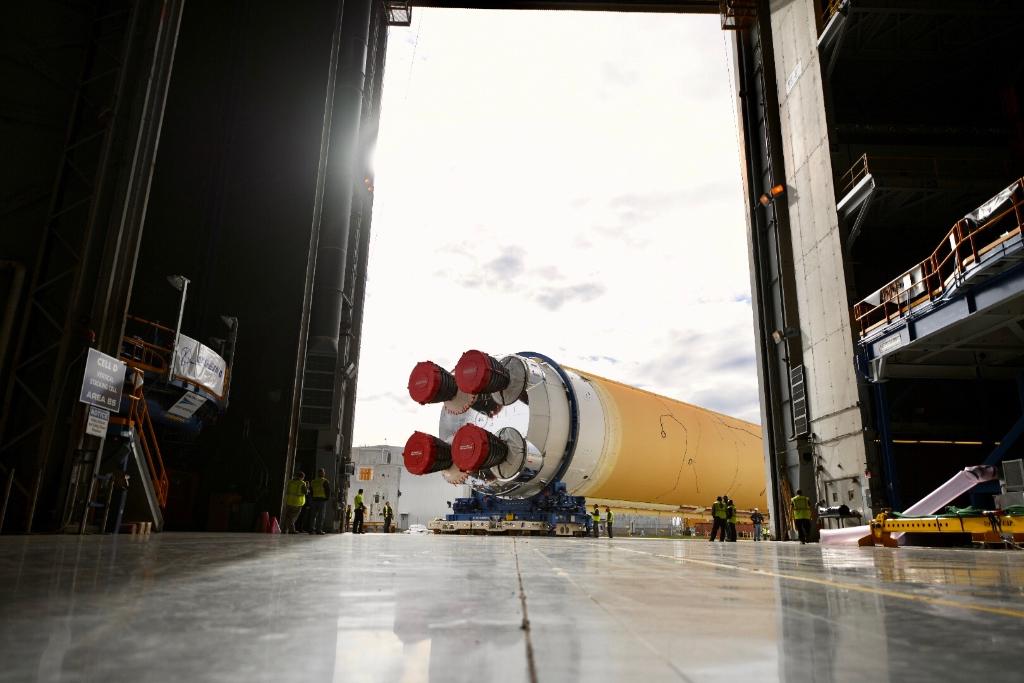NASA Preps Core Stage of Massive Space Launch System Megarocket for Big Test

The core stage of NASA's new megarocket, the massive Space Launch System (SLS), ready to leave its New Orleans home for an epic journey culminating in a space voyage.
The eventual goal of SLS is to ferry astronauts to the moon and more distant destinations, but first, NASA needs to test out the rocket without people on board. NASA has said it hopes to run that test flight – called Artemis 1 – by the end of 2020, but officials have said it could slip to 2021. That flight is expected to have SLS send an Orion spacecraft on a loop from Earth, around the moon and back to our planet again.
But to get that mission ready, NASA needs to ship the 212-foot (65 meters) SLS core stage from its Michoud Assembly Center in New Orleans, Louisiana to a test site in at the agency's Stennis Space Center near Bay St. Louis, Mississippi. The sheer mass and size of the rocket won't easily allow for conventional overland transport, so the core stage will make its journey by barge.
Related: Watch NASA's SLS Megarocket Get Ready for US Moon Missions (Video)
NASA and its contractor teams (led by Boeing) carefully moved the core stage between buildings, to Building 110, at NASA's Michoud Assembly Facility in New Orleans on Jan. 1. This is to get the core stage ready for shipping.
"Making progress," NASA administrator Jim Bridenstine wrote on Twitter later that day. "The massive @NASA_SLS core stage is moving to Building 110 at the Michoud Assembly Facility in Louisiana. There it will be readied for the Pegasus barge and its trip to @NASAStennis. Thank you to the @NASA team for working through the holidays!"
Another picture released on Jan. 3 showed the core stage sitting bare in a Michoud building after engineers removed scaffolding from the core stage.
Breaking space news, the latest updates on rocket launches, skywatching events and more!

"NASA and the contractor team used the scaffolding positioned around the 212-foot core stage to assess the stage's inside and check out the electronic systems distributed throughout the stage, including avionics and propulsion systems, that will enable the stage to operate during launch and flight," the agency said in a statement.
Later in January, the core stage will journey on a Pegasus barge from Michoud to NASA's Stennis Space Center near Bay St. Louis, Mississippi. The core stage will be mounted on the B-2 Test Stand to do what NASA calls the "Green Run" test series – the first full test of the core stage with its flight hardware.
"The comprehensive test campaign will progressively bring the entire core stage, including its avionics and engines, to life for the first time to verify the stage is fit for flight ahead of the launch of Artemis I," NASA stated.

All SLS rockets will fly to space from the Kennedy Space Center in Florida. After Artemis I, NASA plans a second test mission with humans on board in the next couple of years. Then the third mission, Artemis III, is scheduled to put astronauts on the moon in 2024 – roughly 55 years after humanity's first moon landing, Apollo 11, in July 1969.
All told, the core stage is 212 feet tall (65 meters) and includes four engines and two liquid- propellant tanks. "I'm going to call it the ninth wonder of the world," Douglas Loverro, the new head of NASA's Human Exploration and Operations Mission Directorate, said during the event.
Bridenstine's speech was more about celebration than announcements, but the discussion left in the air several concerns that NASA is facing about both the rocket and the larger Artemis program.
NASA has contracts with Boeing for only the first two SLS rockets, Bridenstine said, not later iterations of the launcher. But it's the third rocket in the series that will send astronauts to the moon in 2024 to meet the agency's much-touted goal.
The agency also continued to avoid offering a schedule for Artemis flights or a cost estimate for the SLS rockets. Bridenstine has been demurring on offering a launch date for the uncrewed first Artemis mission, deferring that question to the new director of human exploration. Although he called Loverro up to the stage at the event, no date was announced.
Similarly, NASA has deflected questions about the anticipated price per rocket of the SLS program. In his comments, Bridenstine argued that cost will depend on how many rockets NASA ends up commissioning — the more rockets, the lower the individual price will end up. In October, the agency expressed interest in as many as 10 SLS rockets for the Artemis program.
- NASA Test-Fires Megarocket Engine That May Take Astronauts to the Moon (Video)
- Could NASA Build the Famous Saturn V Today? It's Working on It, with a Twist
- The World's Tallest Rockets: How They Stack Up
Follow Elizabeth Howell on Twitter @howellspace. Follow us on Twitter @Spacedotcom and on Facebook.


Elizabeth Howell (she/her), Ph.D., was a staff writer in the spaceflight channel between 2022 and 2024 specializing in Canadian space news. She was contributing writer for Space.com for 10 years from 2012 to 2024. Elizabeth's reporting includes multiple exclusives with the White House, leading world coverage about a lost-and-found space tomato on the International Space Station, witnessing five human spaceflight launches on two continents, flying parabolic, working inside a spacesuit, and participating in a simulated Mars mission. Her latest book, "Why Am I Taller?" (ECW Press, 2022) is co-written with astronaut Dave Williams.
